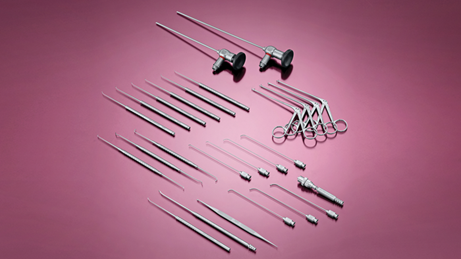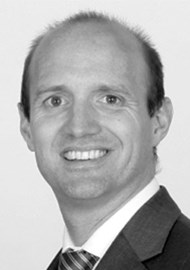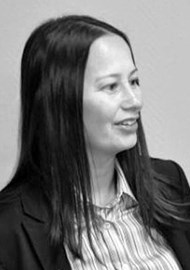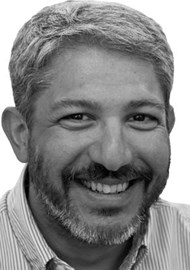Marcus Brechtold, Senior Director of Product Management – Oto-Rhino-Laryngology, OMFS, Spine and Neurosurgery at KARL STORZ GMBH & Co. KG, tells EES Guest Editor, Chris Coulson, about the company’s new Endoscopic Ear Surgery Set, developed in collaboration with the International Working Group on Endoscopic Ear Surgery.
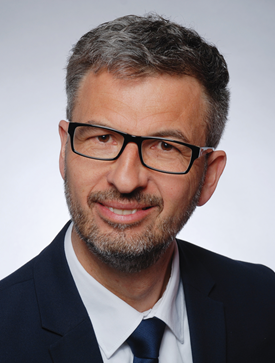
Marcus Brechtold.
Tell us about the background to developing this product.
The company KARL STORZ has a history of developing minimally invasive surgical techniques that allow access to regions that were previously inaccessible and that allow for faster patient recovery. We had therefore already started developing telescopes and special instruments for endoscopic assisted ear surgery in the mid-1980s. These middle ear instruments experienced something of a renaissance with the International Working Group on Endoscopic Ear Surgery (IWGEES) and the advent of new procedures such as removing cholesteatoma endoscopically. Today KARL STORZ offers a diverse range of endoscopes and instruments for middle ear surgery.
Can you inform us of how the idea came about for developing an Endoscopic Ear Surgery Set?
There has been an increasing trend worldwide towards the use of the endoscope in middle ear surgery thanks to new advances in instruments and enhanced visualisation technologies. All ENT specialists who use the endoscope for middle ear surgery realise how the predominant use of the microscope up to now, and its limitations, have influenced clinical perception, e.g. when removing a cholesteatoma.
Enhanced visualisation technologies in combination with the outstanding optical properties of the endoscope, as well as special instruments, offer new perspectives and possibilities in middle ear surgery. These developments have led to a change of thinking in endoscopic middle ear surgery.
The patient stands to benefit most from endoscopic middle ear surgery. One main advantage is the faster recovery of the patient due to a minimally invasive procedure. Moreover, using an endoscope considerably reduces in-situ tumour residue thanks to the enhanced view of the entire surgical site.
In a nutshell, can you explain the product?
The Endoscopic Ear Instrument Set has been specially designed in order to fulfil the requirements of endoscopic ear surgery. The modified instruments allow better control over the pathology and facilitate access to previously unreachable anatomical recesses like the sinus tympani, the facial recess and the anterior epitympanic recess.
Endoscopic ear surgery necessitates 30° or 45° angled endoscopes. In order to visualise the instruments (micro hooks and dissectors), despite the different angulation, the instrument sheaths are now bent to the corresponding degree.
The double ended 90° curved curette is very helpful in removing tissue out of very deep and difficult to reach spots, such as the anterior empitympanic recess.
The suction cannulas are specified by their different angulations and their large choice of diameters. Moreover, the rotating adaptor facilitates the manipulation of the different types of reusable cannulas.
The round knife with integrated suction allows for incising the tissue around the tympanic membrane while at the same time having a clear picture. In endoscopic ear surgery the space in the tympanic cavity is very narrow and limited. Therefore we developed instruments with very delicate tips in order to make it easier for the surgeon to handle them. This is also one of the reasons why we decided to include integrated suction with only the round knife.
The main difference with this new range of micro cupped forceps is the working length. When working via a trans-canal approach the additional 2cm in length allow for more comfortable manipulation of the instruments.
The KARL STORZ Endoscopic Ear Instrument Set.
Can you describe how the development progressed – how long did it take?
How many people were involved? When the IWGEES group approached us to discuss the possibilities for a special Endoscopic Ear Surgery Set and further modifications of existing instruments we could see that the work in this field was becoming well recognised, and that due to the technical advancements the time had come to promote EES to a wider audience. Until then endoscopic ear surgery was only done by experts in this field, as the working space in these structures is limited. However, with the development and improvement of telescopes and instruments, every ear surgeon can learn to perform endoscopic ear surgery.
The modification and development of the Endoscopic Ear Surgery Set happened in a lively exchange between IWGEES members and KARL STORZ. Two product managers from our side were integrated in the project group to translate the wishes and ideas of the IWGEES members into great functioning instruments. The instruments used in this set are mostly modified instruments that already existed. However, those seemingly small modifications have an extensive effect on the surgery itself; for example the instruments are not in the way of the endoscope anymore and the bending of the tips allows the surgeon to reach previously inaccessible regions.
The continuous exchange with IWGEES members – which is still ongoing – is extremely important to develop instruments that are really of use for this new technique.
What is your involvement in the product, and how did you get involved?
As the Senior Director for Product Management I accompanied this project from the very beginning. I took part in the first meetings with IWGEES members, where we discussed the potential of endoscopic ear surgery and decided how to proceed. When developing or modifying a new product it is always important to have an intensive exchange between surgeons on one hand and developers and product managers on the other. So I also took part in testing the first prototypes together with members of the IWGEES during different workshops until we were finally satisfied with the quality and could present it to a wider audience in 2013.
What challenges did you face when developing this product?
First of all you need to understand that the field of middle ear surgery is still widely dominated by the use of microscopes. What we want to offer is an alternative, so that surgeons can also take a look “around the corner” and therefore see the whole tympanic cavity. This partly means a paradigm shift, as surgeons in this field are not yet used to working only via the monitor and to having less space while operating. We are aware that surgeons need time to learn this new technique and we are trying to overcome this challenge by offering a wide variety of courses to our customers.
These factors meant that we would need a convincing group of experienced surgeons who are passionate and willing to push this technique further. The IWGEES has members from all around the world who are working with us to offer patients a less invasive technique when needing middle ear surgery.
Thanks to our experience and knowledge in manufacturing high quality endoscopes and instruments and as a result of the fruitful cooperation with the IWGEES we can definitely say that this journey is well on track.
Are there any plans for further developments?
We are continually developing our products to support surgeons in their daily routines as best as possible. A particular challenge we face with endoscopic ear surgery, where space is limited, is to further minimise optical systems while at the same time enhancing image quality. With the introduction of the camera system IMAGE1 S which also allows the use of different visualisation modes, like CLARA and CHROMA, we have made a major step forward. These visualisation modes allow an even better and brighter look into the tympanic cavity. More developments are on their way to make life even easier for EES surgeons.
How can we find out more?
For more information concerning the work of the IWGEES and their operation technique we recommend you visit their homepage, (http://www.sinuscentro.com.br/iwgees/). Here you can also find interesting videos showing the instrument set in use. Additionally you will find details of upcoming courses. The KARL STORZ website (www.karlstorz.com) also provides you with brochures on the Endoscopic Ear Instrument Set and interactive doctor-to-doctor manuals, written by various IWGEES members. If you want to see a live demonstration of the instrument set we would be happy to welcome you to our booth at the International Conference on Cholesteatoma and Ear Surgery (CHOLE) in Edinburgh this June.

